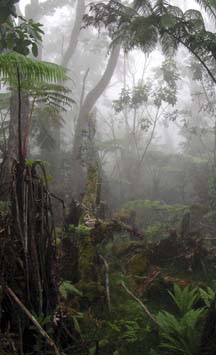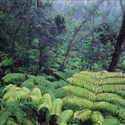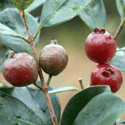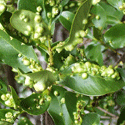Pacific Southwest Research Station
| Pacific Southwest Research Station | |
| About Us | |
| Contact Us | |
| Employment | |
| FAQ'S | |
| Newsroom | |
| Publications | |
|
Pacific Southwest Research Station (510) 559-6300 |
|
|
Research Topics: Biological ControlBiological Control of Strawberry Guava in HawaiiMore Information
Within a short time after establishment, this invasive fruiting tree forms dense, nearly impenetrable thickets that crowd native species, break up natural areas, and disrupt native animal communities. Strawberry guava thickets also provide refuge for two fruit flies [2.1 MB pdf] that cost Hawaiian agriculture millions of dollars each year in lost potential revenue. Years of mechanical and chemical treatments have been expensive and largely ineffective in stopping strawberry guava's growth and spread. Without an effective and sustainable means of control, the invasive tree may eventually invade and degrade nearly half of the state's total land area. For the past 15 years, scientists at the U.S. Forest Service's Institute of Pacific Islands Forestry and colleagues in Brazil and Florida have been conducting rigorous research to develop a biological means of stopping strawberry guava's growth and spread. Their work culminated in 2005, when they prepared a proposal to introduce to Hawaii a carefully studied insect, Tectococcus ovatus, that can help to keep the plant's population in check. Explore this Web site to learn more about strawberry guava and the threat it poses to native forests and how the Institute of Pacific Islands Forestry proposes to manage the invasive tree using biological control. Native Forests: A Resource at Risk
Strawberry Guava: Not All Green Is Good
Biocontrol: Protection on a Large Scale, for the Long Run
|
 Hawaii's native forests are undergoing a silent siege. Each year, countless acres of native forest and land are invaded and degraded by nonnative
Hawaii's native forests are undergoing a silent siege. Each year, countless acres of native forest and land are invaded and degraded by nonnative  Native forests and the many products and services they provide are seriously threatened by invasive species.
Native forests and the many products and services they provide are seriously threatened by invasive species.  Though it yields fruit and wood, strawberry guava is one of the most serious threats facing Hawaii's native forests.
Though it yields fruit and wood, strawberry guava is one of the most serious threats facing Hawaii's native forests.  No stranger to Hawaii, biological control complements other techniques and offers a safe and effective means for managing invasive species.
No stranger to Hawaii, biological control complements other techniques and offers a safe and effective means for managing invasive species.